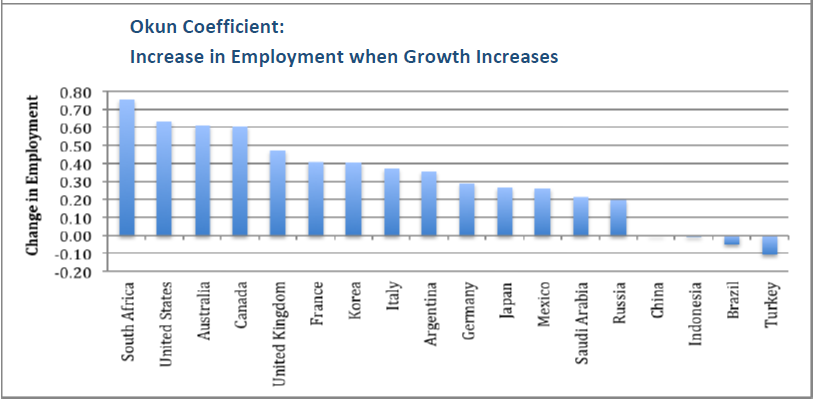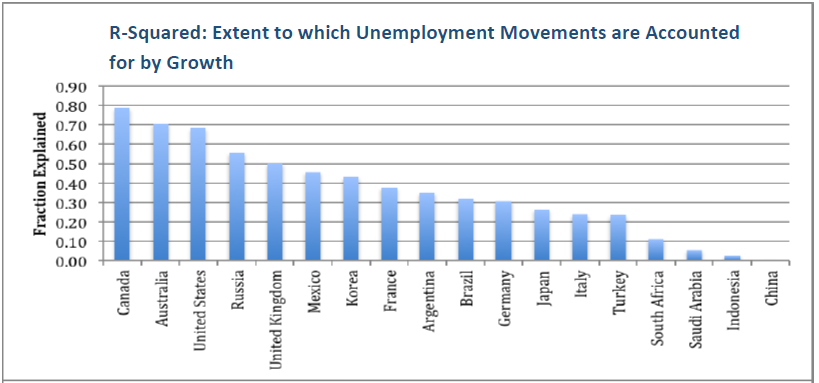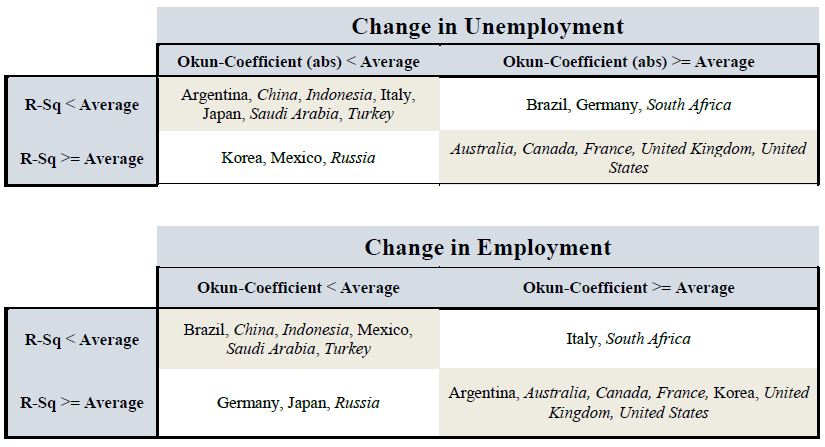Does Growth Create Jobs in the G-20 Economies?
Unemployment remains a global concern: if they formed their own country, the unemployed would constitute the fifth most populous country in the world (Lagarde 2014 and International Jobs Report). Reducing unemployment was endorsed as a policy priority at the G-20 Leaders Summit last November. But what concretely can be done to create jobs and lower unemployment?
One open issue is whether a pick-up in economic growth leads to job creation in the short run (say, over the course of a year). This brief provides evidence on this issue by studying the historical link between jobs and growth. The main finding is that growth leads to jobs but the strength of the link varies considerably across countries.
The evidence that extra growth will bring back jobs in many countries leads to the obvious question: what will deliver the extra growth? In Furceri and Loungani (2014), we advocate a two-handed approach: continued support to domestic aggregate demand and the adoption of policies and reforms that can boost aggregate supply. Without supportive demand policies, supply measures could have little impact in the short run. If companies do not see improved sales prospects, they will not increase capacity; hence, it is essential to ensure that the demand is there to sustain supply. But without supply measures, output gains based solely on a stimulus to demand will prove temporary. For G-20 policymakers, the message is that, while not a panacea, growth is an essential part of the cure for unemployment.
Evidence on the Jobs-Growth Link
Consider the top panel of Figure 1 which shows the extent to which unemployment falls in different countries when growth picks up. In Australia, an additional percentage point of growth lowers the unemployment rate by half a percentage point; in China there is no effect.
Figure 1: The Jobs-Growth Link in G20 Countries


The bottom panel of Figure 1 shows how much employment increases when growth picks up. In South Africa, a 1% increase in growth is matched by a 0.75% increase in employment. In contrast, there is virtually no response of employment to growth in Brazil, China, Indonesia and Turkey.
Figure 2: How Important is Growth for Jobs?


Figure 2 shows the extent to which changes in growth account for changes in unemployment and employment. In the top panel, we see that nearly 80 percent of the variation in Canada’s unemployment rate can be accounted for by short-run fluctuations in growth; in Mexico this figure is about 40 percent, in Turkey 20 percent, and in China it is zero. In the bottom panel, we see that growth accounts for over 70 percent of the variation in employment in Canada and the United States, about 40 percent in Russia, the United Kingdom and Australia, and very little in many other countries.
Summarizing the evidence on the jobs-growth link
In short, there are large variations across countries in the jobs-growth link—known in economic jargon as the ‘Okun coefficient’ (see the Annex)—and in the extent to which growth accounts for labor market movements—the ‘R-square statistic’ in the jargon. Can this evidence be summarized in some way?
Figure 3: The Jobs-Growth Link—Summarizing the Evidence

Figure 3 tries to do so by combining the information on the Okun coefficient and the R-square statistic to classify countries into four quadrants.
Consider the top panel of Figure 3. For the countries listed in the southeast quadrant (Australia and several others), the unemployment-growth link is strong: unemployment is fairly responsive to growth and fluctuations in growth account for a large chunk of fluctuations in unemployment. For the countries listed in the northwest quadrant (Argentina and several others), one could say that the unemployment-growth link is weak: unemployment does not respond to growth and fluctuations in growth do not account for much of unemployment fluctuations.
What about the two remaining quadrants? In countries in the northeast quadrant—Brazil, Germany and South Africa—the unemployment rate is responsive to growth but variations in growth do not appear to be the predominant drivers of unemployment fluctuations. In countries in the southeast quadrant—Korea, Mexico, Russia— the unemployment rate is not very responsive to growth but factors other than growth do not appear to be driving unemployment fluctuations.
A similar analysis can be conducted for the bottom panel of Figure 3, which summarizes the evidence on the link between employment and growth. (Countries shown in italics in Figure 3 appear in the same quadrant for both unemployment and employment cases.)
Changes during the Great Recession
We next compare the strength of the jobs-growth link (i.e. the Okun coefficient) over the time period 1980 to 2007 with that over the time period 1980 to 2014. Does including the period of the Great Recession alter our view of the historical relationship? We draw two main conclusions from the evidence shown in Figure 4. First, for most countries, the link has not changed much. In particular, the large cross-country variations remain intact. Second, there is no easy story (that at least we can tell) for why the relationship got a bit stronger in some countries and a bit weaker in others.
Figure 4: Change in Jobs-Growth Link in Recent Years

Conclusion
In the short run, unemployment depends in large part on what happens to growth. Triggering growth requires both demand measures—traditionally thought of as the domain on Finance Ministers and supply measures—more under the purview of Labor and Employment Ministers. It is good when the two ministries unite in the cause of lowering unemployment.










